Crater constellation is located in the southern sky. Its name means “the cup” in Latin.
Crater is one of the Greek constellations. In mythology, it represents the cup of the Greek god Apollo. The constellation was first catalogued by the Greek astronomer Ptolemy in the 2nd century.
Crater is relatively faint, with no stars brighter than fourth magnitude. There are also few notable deep sky objects in the constellation. Most galaxies found in Crater are magnitude 12 or fainter. One of these, the Crater 2 dwarf galaxy, is the fourth largest dwarf galaxy orbiting the Milky Way, but it went undetected until April 2016 because it is also one of the lowest surface brightness dwarfs.
Facts, location and map
Crater is the 53rd constellation in size, occupying an area of 282 square degrees. It is located in the second quadrant of the southern hemisphere (SQ2) and can be seen at latitudes between +65° and -90°. The neighboring constellations are Corvus, Hydra, Leo, Sextans, and Virgo.
The constellation name Crater is pronounced /ˈkreɪtər/. In English, the constellation is known as the Cup. The genitive form of Crater, used in star names, is Crateris (pronunciation: /krəˈtɪərɪs/). The three-letter abbreviation, adopted by the International Astronomical Union (IAU) in 1922, is Crt.
Crater belongs to the Hercules family of constellations, along with Aquila, Ara, Centaurus, Corona Australis, Corvus, Crux, Cygnus, Hercules, Hydra, Lupus, Lyra, Ophiuchus, Sagitta, Scutum, Sextans, Serpens, Triangulum Australe, and Vulpecula.
Crater has three stars with known planets and contains no Messier objects. The brightest star in the constellation is Delta Crateris, with an apparent magnitude of 3.56. There is one meteor shower associated with the constellation; the Eta Craterids.
Crater contains three named stars. The names of stars that have been officially approved by the International Astronomical Union (IAU) are Alkes, Amansinaya, and Hunahpú.
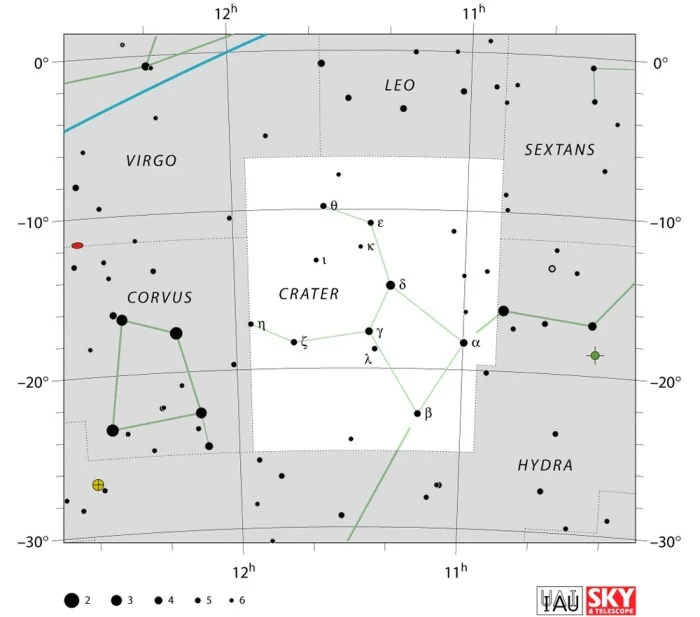
Crater constellation map by IAU and Sky&Telescope magazine
Crater myth
In Greek mythology, the Crater constellation represents the cup of the god Apollo. The cup is usually depicted as a two-handed chalice. The constellation is associated with the story of Apollo and his sacred bird, either the crow or the raven, which is represented by the neighbouring constellation Corvus.
In the story, the god Apollo is about to make a sacrifice on the altar and he needs some water to perform the ritual. The god sends the raven to promptly fetch some water in his cup, but the bird gets distracted by a fig tree and spends a few days lazily resting and waiting for the figs to ripen.
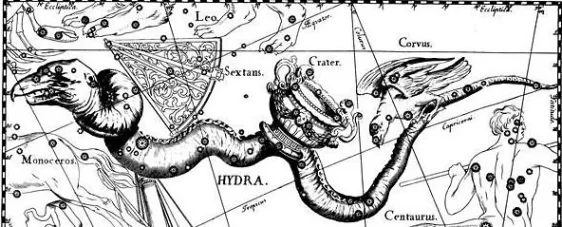
Hydra, Corvus and Crater constellations in Johannes Hevelius Celestial Atlas
After feasting on the figs, the raven finally brings Apollo the cup filled with water and he also brings a water snake (Hydra) as an excuse for being so late. Apollo sees through the raven’s lies and angrily casts all three – the cup (Crater), the water snake (Hydra) and the raven (Corvus) into the sky.
Apollo also casts a curse on the raven, scorching its feathers and making the bird eternally thirsty and unable to do anything about it. This, according to the myth, is how crows and ravens came to have black feathers and why they have such raspy voices.
Crater stars
Labrum – δ Crateris (Delta Crateris)
Delta Crateris is an orange giant, approximately 196 light years distant. The star belongs to the spectral class K0III and has an apparent magnitude of 3.56. It is the brightest star in the constellation.
Delta Crateris is sometimes known as Labrum, which means “the lip” in Latin. The name is associated with the story of the Holy Grail.
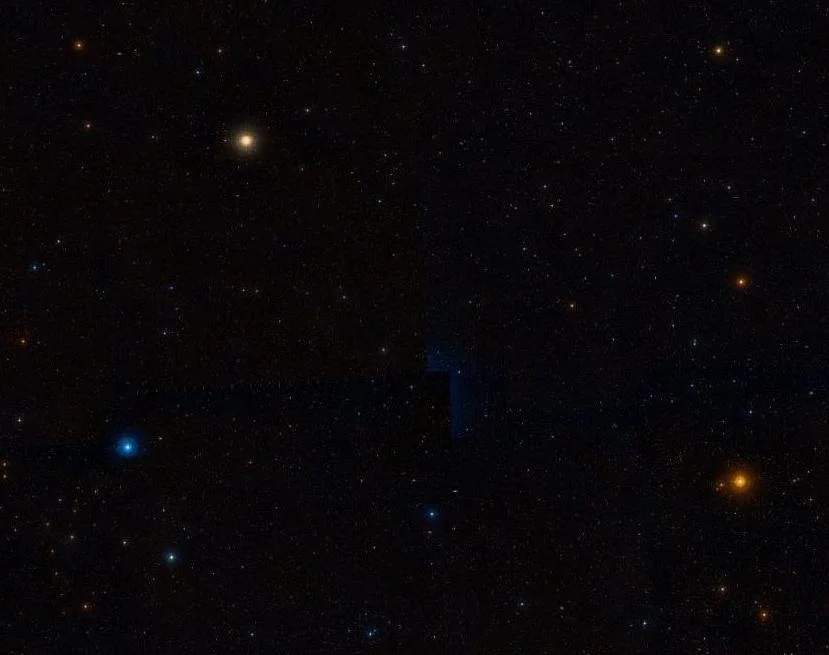
Delta (upper left), Gamma (lower left) and Alpha Crateris (right), image: NASA (Wikisky)
Alkes – α Crateris (Alpha Crateris)
Alkes, Alpha Crateris, is a class K1 orange giant, approximately 174 light years from Earth. It has a visual magnitude of 4.07. It is located relatively close to the Galactic centre and is rich with heavy elements.
Alkes is 80 times more luminous than the Sun. Its traditional name is derived from the Arabic alkās, which means “the cup.”
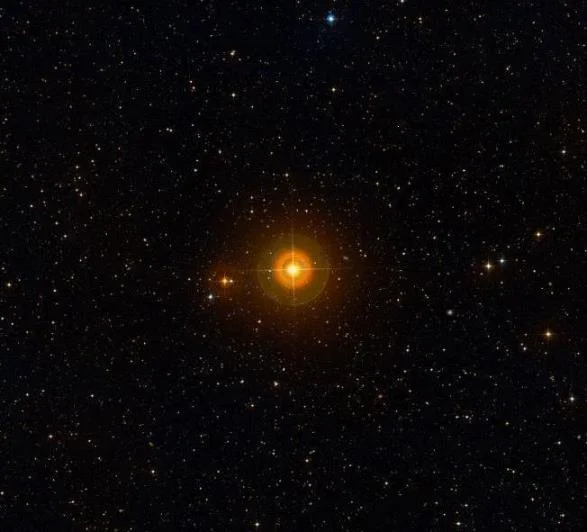
Alkes (Alpha Crateris), image: NASA (Wikisky)
Al Sharasif – β Crateris (Beta Crateris)
Beta Crateris is a white sub-giant belonging to the spectral class A2III. The star has an apparent magnitude of 4.48 and is approximately 266 light years distant from the solar system.
Beta Crateris is sometimes known by its traditional name, Al Sharasif, which means “the ribs” in Arabic. The star shares the name with Nu Hydrae.
γ Crateris (Gamma Crateris)
Gamma Crateris is the second brightest star in Corvus. It is a close binary star approximately 84 light years distant. The brighter component in the system is a white dwarf, a class A9V star with an apparent magnitude of 4.06. The companion star has a visual magnitude of 9.6.
SZ Crateris
SZ Crateris is a variable star only 42.9 light years distant from Earth. It has a visual magnitude that varies from 8.61 to 11.0. It is really a binary star system composed of two main sequence stars, belonging to the spectral types K5V and M0V.
SZ Crateris is a BY Draconis type variable, a star exhibiting variations in luminosity as a result of its rotation, star spots and other activity in its chromosphere. The star’s optical period is 11.58 days. It is believed to be less than 200 million years old.
The system belongs to the Ursa Major moving group (Collinder 285), a group of stars that share a similar motion through space, which includes most of the brightest stars in the constellation Ursa Major.
R Crateris
R Crateris is a SRb-type semi-regular variable star belonging to the spectral class M7. The star has an apparent magnitude that varies between 9.8 and 11.2 and an optical period of 160 days.
Deep sky objects in Crater
NGC 3887
NGC 3887 is an 11th magnitude barred spiral galaxy in Crater. It has a diameter of 3.5’.
The galaxy lies about a degree and half from the star Zeta Crateris. It has an apparent magnitude of 10.7 and is about 68 million light years distant. It was discovered in 1785 by Sir William Herschel.
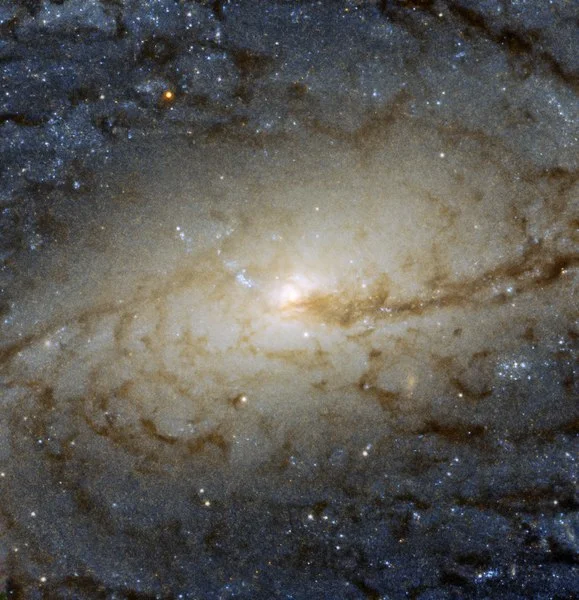
The barred spiral galaxy NGC 3887, seen here as viewed by the Wide Field Camera 3 aboard the NASA/ESA Hubble Space Telescope, lies over 60 million light-years away from us in the southern constellation of Crater (The Cup); it was discovered on 31 December 1785 by the German/British astronomer William Herschel. Its orientation to us, while not exactly face-on, allows us to see NGC 3887’s spiral arms and central bulge in detail, making it an ideal target for studying a spiral galaxy’s winding arms and the stars within them. The very existence of spiral arms was for a long time a problem for astronomers. The arms emanate from a spinning core and should therefore become wound up ever more tightly, causing them to eventually disappear after a (cosmologically) short amount of time. It was only in the 1960s that astronomers came up with the solution to this winding problem; rather than behaving like rigid structures, spiral arms are in fact areas of greater density in a galaxy’s disc, with dynamics similar to those of a traffic jam. The density of cars moving through a traffic jam increases at the centre of the jam, where they move more slowly. Spiral arms function in a similar way; as gas and dust move through the density waves they become compressed and linger, before moving out of them again. Image: ESA/Hubble & NASA, P. Erwin et al.
NGC 3511
NGC 3511 is a spiral galaxy in Crater, seen almost edge-on. The galaxy has an apparent magnitude of 11.1. It belongs to the Abell 1060 galaxy cluster.
NGC 3511 has a slight bar and is classified as a SBbc type galaxy. It was discovered by William Herschel on December 21, 1786.
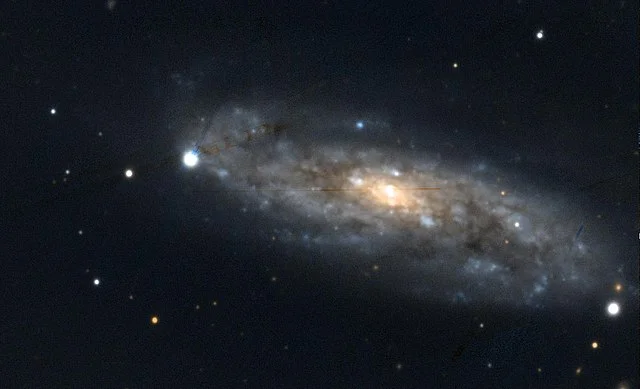
NGC 3511, image: NASA (PanSTARRS-1 archive)
NGC 3513
NGC 3513 is also a spiral galaxy, found in the same field of view as NGC 3511. It has an apparent magnitude of 12 and lies approximately 46 million light years from Earth.
NGC 3981
NGC 3981 is a magnitude 12 SBbc type spiral galaxy. It has two very wide spiral arms and is 3’ in diameter. Like NGC 3887, NGC 3981 was discovered by Sir William Herschel in 1785. It is approximately 80 million light years distant from Earth.
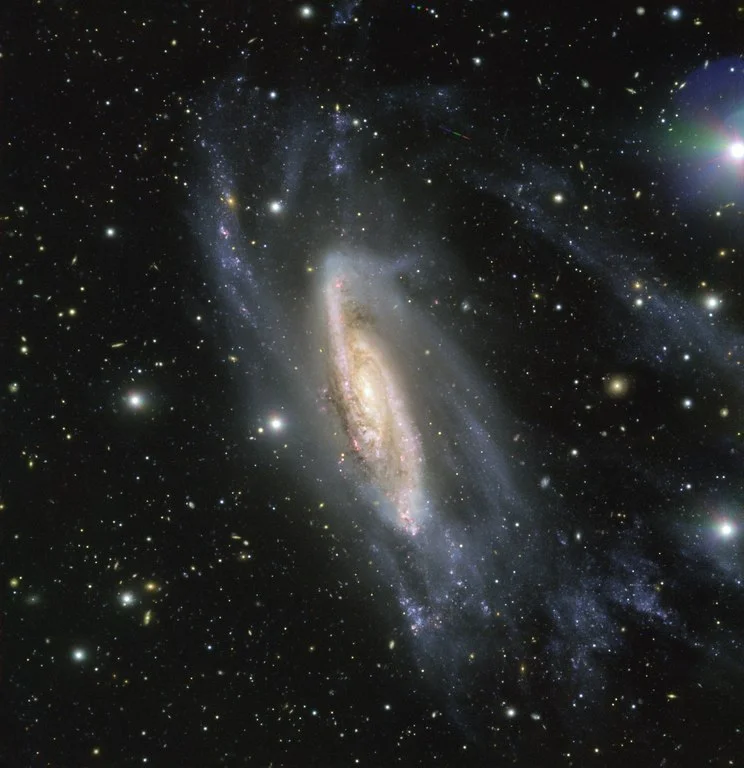
FORS2, an instrument mounted on ESO’s Very Large Telescope captured the spiral galaxy NGC 3981 in all its glory. The image, captured during the ESO Cosmic Gems Programme, showcases the beauty of the southern skies when conditions don’t allow scientific observations to be made. Image: ESO
Crater 2
Crater 2 is one of the dwarf galaxies orbiting the Milky Way. It is the fourth largest dwarf orbiting our galaxy, smaller only than the Large Magellanic Cloud, Small Magellanic Cloud and the Sagittarius Dwarf.
The galaxy lies at a distance of only about 380,000 light years from the Sun. In spite of its size and proximity, Crater 2 was only discovered in 2016 because its stars are spread out from one another, which led researchers to nickname the galaxy “the feeble giant.”